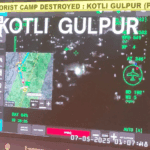Unlike previous Indian operations, Operation Sindoor was technologically advanced, expansive, and unprecedented in scale. The mission deep inside Pakistan-occupied territory marked a shift from India’s previous military doctrine. Operation Sindoor was the largest cross-border strike since the 2019 Balakot operation, signifying a strategic evolution.
“Militant losses sent a strong message—India now has the right to preemptively strike anywhere,” said a government source. The strikes followed the April 22 attack in Pahalgam, Jammu and Kashmir, killing 26 civilians.
Also Read: Shah Rukh Khan stuns with a regal debut at Met Gala 2025, posing and owning the spotlight.
Intelligence linked the attackers to Lashkar-e-Taiba (LeT), a Pakistan-based terror group targeting Indian civilians and forces. Operation Sindoor aimed not only as retaliation but to weaken terrorism’s logistical base in Pakistan.
Also Read: Pakistan Shells Civilian Areas After India’s Operation Sindoor, 7 Killed, 38 Injured
The Targets
The operation struck nine locations across Pakistan and Pakistan-occupied Kashmir. These included Muzaffarabad, Kotli, Bahawalpur, Rawalakot, Chakswari, Bhimber, Neelum Valley, Jhelum, and Chakwal. The total number of missile strikes stood at 24, making this the most extensive single-day precision operation India has ever executed.
“Over 70 militants were killed and 60 others injured during the coordinated attack,” said a government source. Each target was under long-term surveillance, with intelligence gathered from satellite images, human sources, and intercepted communications.
Indian intelligence identified compounds used by Jaish-e-Mohammad (JeM) and Lashkar-e-Taiba (LeT) for militant activities. The buildings were labeled as indoctrination centers, arms depots, logistical hubs, and sleeper cell facilities. In many cases, UAV surveillance was conducted days before to track movement and confirm terrorist activity.
Weapons and Platforms
Operation Sindoor involved coordinated deployment of air, naval, and land-based military assets by Indian armed forces. The operation used SCALP cruise missiles, HAMMER bombs, and loitering munitions launched from Indian Air Force jets. These aircraft operated from deep within Indian territory, supported by mid-air refuelling and early-warning surveillance systems.
SCALP missiles, with 250+ km range, targeted fortified bunkers and enemy command centers. HAMMER bombs struck multi-storey buildings believed to house terrorist leaders and training facilities. Loitering munitions, or kamikaze drones, provided surveillance and targeted high-value mobile assets as they appeared.
Also Read: How the 9 Targets in Pakistan Hit During Operation Sindoor Supported Terrorism
“All missiles hit targets within an hour, with real-time UAV footage confirming destruction,” a government source said. Strikes were synchronised for surprise and to avoid detection, marking a strategic shift in Indian doctrine.
The Full List of Sites Targeted
1. Markaz Subhan Allah, Bahawalpur – JeM
2. Markaz Taiba, Muridke – LeT
3. Sarjal, Tehra Kalan – JeM
4. Mehmoona Joya, Sialkot – HM
5. Markaz Ahle Hadith, Barnala – LeT
6. Markaz Abbas, Kotli – JeM
7. Maskar Raheel Shahid, Kotli – HM
8. Shawai Nalla Camp, Muzaffarabad – LeT
9. Syedna Bilal Camp, Muzaffarabad – JeM











More Stories
Shah Rukh Khan Sports Rs 21-Crore Watch at Met Gala 2025 – Here’s Why It Costs a Fortune
ऑपरेशन सिंदूर ने बॉलीवुड में भरा जोश, अक्षय बोले- जय हिंद; अनुपम समेत इन्होंने दिया रिएक्शन
OPERATION SINDOOR: भारत की कार्रवाई पर वैश्विक प्रतिक्रियाएं